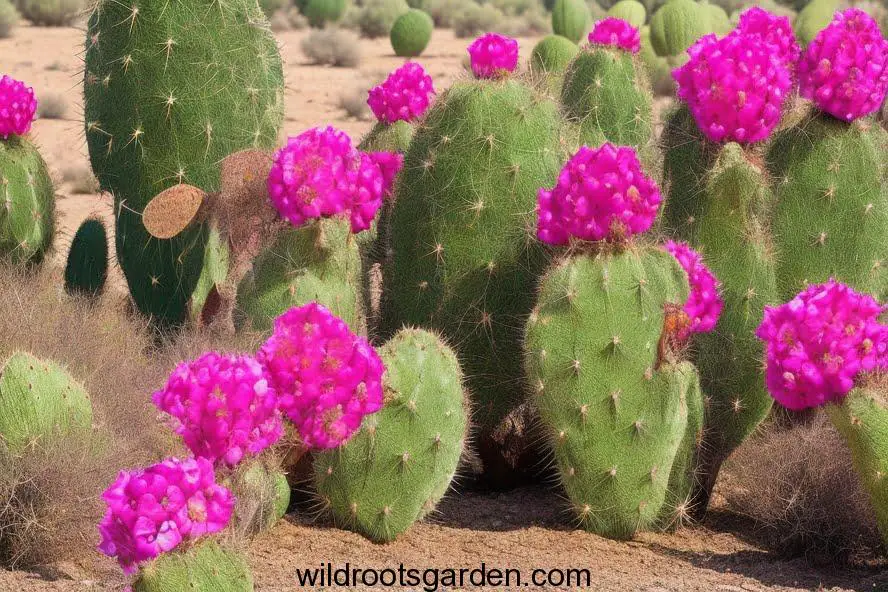Adaptations of the Prickly Pear Cactus. The Opuntia, or prickly pear cactus, is a fascinating plant that has successfully adapted to a variety of habitats all around the world. Its capacity to thrive in difficult and arid environments has resulted in a number of adaptations that guarantee its longevity. This introduction examines the unique traits and techniques used by the prickly pear cactus to withstand harsh weather, preserve water, and fend off herbivores with its thorny shell. It also explores the relevance of cacti in traditional medicine and cuisine, as well as their function in providing wildlife with vital supplies. This unusual plant species’ incredible resiliency can be better understood by understanding these adaptations.
The Cactaceae family’s Prickly Pear cactus is distinguished by its prominent spines, substantial fleshy pads, and colorful flowers. It is native to the Americas, but because of its toughness and adaptability, it has been spread to various regions of the globe. Due to its unusual characteristics, which enable it to survive in settings where few other plants can grow, this cactus has interested scientists and researchers for generations.
What is the Prickly Pear Cactus?

A succulent plant in the genus Opuntia, the prickly pear cactus is also referred to as the nopal cactus. It includes more than 200 species, all of which have evolved similarly to survive in arid areas. These cacti are recognized for their vivid flowers that bloom in a variety of colors, including yellow, orange, and red. They often have flat, pad-like stems covered in sharp spines.
Physical Adaptations
Spines and Thorns
The Prickly Pear cactus’ spines and thorns are among its most striking adaptations. These pointed structures have several uses. First of all, they discourage herbivores from eating the cactus by acting as a deterrent to them. Second, by forming a layer of still air around the cactus that lessens evaporation, they aid in reducing water loss. Moreover, the cactus’s surface is shaded by the spines, protecting it from direct sunlight.
Thick, Fleshy Pads
Thick, fleshy pads of the prickly pear cactus act as reservoirs for water. The cactus can withstand extended droughts thanks to the large water-holding capacity of these pads. The cactus can generate energy through the process of photosynthesis thanks to the pads’ additional role as photosynthetic organs.
Waxy Cuticle
The Prickly Pear cactus has a waxy coating that reduces water loss through transpiration. The cactus’ surface is covered in a cuticle, which limits the quantity of water that may evaporate. It helps the cactus retain moisture by serving as a layer of defense against the harsh desert environment.
Shallow Root System
The short root system of the prickly pear cactus extends horizontally at the ground’s surface rather than vertically. This modification increases the cactus’ ability to efficiently acquire water in dry situations by allowing it to swiftly absorb any rain or dew that falls.
Water Storage Adaptations

Succulent Tissues
The Prickly Pear cactus has evolved succulent tissues that can store large quantities of water. These tissues are present in the fleshy pads and allow the cactus to store water during periods of rainfall or high humidity. This stored water acts as a reservoir that the cactus can draw upon during dry spells.
Efficient Water Absorption
The roots of the Prickly Pear cactus have specialized structures, such as root hairs, that enhance water absorption. These adaptations enable the cactus to quickly absorb water when it becomes available, increasing its chances of survival in water-scarce environments.
Reduced Transpiration
To conserve water, the Prickly Pear cactus has adapted to minimize transpiration. Transpiration is the process by which plants lose water through their leaves. The cactus achieves this by reducing the surface area available for transpiration, thanks to its modified leaves in the form of fleshy pads, as well as the presence of the waxy cuticle.
Sunlight and Heat Adaptations
CAM Photosynthesis
The Prickly Pear cactus employs a unique form of photosynthesis called Crassulacean Acid Metabolism (CAM). CAM photosynthesis allows the cactus to open its stomata (tiny pores on the surface) during the night when temperatures are lower and moisture loss is minimized. The cactus then closes its stomata during the day to conserve water while still being able to perform photosynthesis using the stored carbon dioxide.
Reflective Surface

The Prickly Pear cactus often has a reflective surface due to its thick cuticle and surface spines. This reflective surface helps to reduce the amount of solar radiation absorbed by the cactus, thereby preventing overheating and reducing water loss through evaporation.
Reproduction Adaptations
Flowers and Pollination
The Prickly Pear cactus produces vibrant, showy flowers that attract pollinators such as bees, butterflies, and birds. These flowers are usually large and contain nectar, enticing pollinators to visit and transfer pollen between plants. The cactus relies on these pollinators for successful reproduction, ensuring the continuation of its species.
Fruits and Seed Dispersal
Tunas are the fruits that the prickly pear cactus produces after successful pollination. These edible fruits are seeded with countless tiny seeds. The cactus has modified to produce juicy, delicious, and nutrient-rich fruits that draw animals to eat them. As a result of the seeds being spread by the animals’ digestive systems, new cactus plants can grow in various places.
Defense Mechanisms
Spines and Thorns
As its main protection against herbivores, the prickly pear cactus uses thorns and spines. The cactus’ water-rich tissues are protected by the sharp spines, which keep animals from eating or approaching it. Moreover, the spines operate as a physical barrier that keeps predators away from the cactus’s succulent pads.
Toxic Chemicals
The prickly pear cactus has evolved chemical defenses in addition to physical ones. It generates noxious substances like alkaloids, which render the cactus unpleasant or even lethal to potential herbivores. These substances act as an additional layer of defense, discouraging animals from eating the cactus.
Protective Mucilage
The Prickly Pear cactus produces a sticky mucilage, a slimy substance, on its surface. This mucilage acts as a protective layer, preventing water loss through evaporation and also deterring herbivores. When an animal tries to bite into the cactus, the mucilage can make it difficult to extract the spines, discouraging further feeding attempts.
Geographic Adaptations
Desert Habitats
The prickly pear cactus thrives in arid environments where water is in short supply and temperatures can vary greatly. Whereas many other plants struggle to grow in these severe settings, it can survive thanks to its water storage abilities and reduced transpiration.
Drought Tolerance
The Prickly Pear cactus has a great endurance for drought because of its succulent tissues and effective water absorption. It thrives in arid locations because it can withstand extended dry spells and survive with little rain.
Cold Resistance
Several Prickly Pear cactus species have evolved adaptations to withstand freezing temperatures. By lowering their water content and going dormant in the winter, they can resist cold temperatures. Because to this adaptation, the cactus may live in high-altitude places with cold weather.
Human Uses and Economic Significance
Culinary Uses
Several tribes throughout the world use the prickly pear cactus in their food. The juvenile pads, also known as nopales, are treasured for their nutritional benefits and frequently eaten as vegetables. They add a distinct flavor and texture to salads, stews, and other meals when cooked and added to them.
Medicinal Properties
Prickly Pear cacti have been used in traditional medicine for centuries. They are believed to have various health benefits, including anti-inflammatory and antioxidant properties. Extracts from the cactus have been used to treat conditions such as diabetes, high cholesterol, and gastrointestinal disorders.
Ornamental Plant
The Prickly Pear cactus is also popular as an ornamental plant. Its unique shape, vibrant flowers, and adaptive nature make it an attractive addition to gardens and landscapes. It can thrive in pots or in the ground, adding a touch of desert beauty to various environments.
Conservation and Environmental Impact
The prickly pear cactus is vital to the survival of many animal species in desert settings because it provides them with food and protection. Yet, it faces serious challenges to its survival from invasive species and habitat degradation. To save the Prickly Pear cactus and guarantee the survival of its distinctive adaptations for future generations, conservation activities are essential.
In conclusion, the Prickly Pear Cactus’ modifications show how inventive nature can be when overcoming challenging conditions. The genius of evolution is demonstrated by its amazing capacity to survive extremely high or low temperatures, preserve water, and deter predators with its thorny defenses. Furthermore, its critical function as a source of resources for wildlife, as well as its significance in traditional medical and culinary, practices highlights its value in both ecological and human contexts. We learn important lessons about how species may survive in difficult environments as we study and appreciate these adaptations. This knowledge motivates us to value and safeguard the delicate balance of our natural environment. The Prickly Pear Cactus is a symbol of adaptation’s miracles and a constant reminder of nature’s beauty and toughness.
FAQs
Q1: Can I grow a Prickly Pear cactus in my garden?
Yes, Prickly Pear cacti can be grown in gardens, especially in regions with dry and arid climates. Ensure they have well-draining soil and provide sufficient sunlight. Take caution while handling the spines and provide adequate space for the cactus to grow.
Q2: Are all Prickly Pear cacti edible?
While many Prickly Pear cacti produce edible pads and fruits, not all species are suitable for consumption. It is essential to properly identify the species and ensure they are safe to eat before harvesting or consuming any parts of the cactus.
Q3: Are Prickly Pear cacti endangered?
While some species of Prickly Pear cacti face conservation concerns due to habitat loss and invasive species, the overall group is not considered endangered. However, it is essential to be mindful of their conservation status and promote responsible cultivation and preservation practices.
Q4: Can Prickly Pear cacti survive in cold climates?
Certain species of Prickly Pear cacti have adaptations that allow them to tolerate cold temperatures. However, extreme cold and frost can still damage or kill the cactus. It is advisable to choose cold-hardy species and provide appropriate protection during freezing weather.
Q5: Can Prickly Pear cacti be used in skincare products?
Yes, extracts from Prickly Pear cacti are increasingly being used in skin care products due to their hydrating and antioxidant properties. These extracts can help moisturize the skin, reduce inflammation, and protect against oxidative stress.

